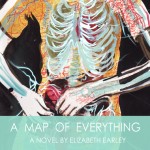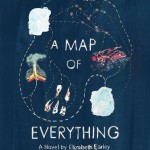By Christine Rice
In my mind’s eye, I see Elizabeth Earley waiting for class to start, leaning forward in her seat, looking fiercely determined. Everything about her screamed, Let’s get this started already.
It’s not surprising then that, seven years later, Earley’s debut novel, A Map of Everything, is forthcoming from Jaded Ibis Press.
The novel revolves around a devastating accident and the tangled mess of grief, tragedy, love, and despair that follows. It’s narrated by Anne — the family’s youngest, its “fifth born.” She’s bewildered but reliable, bowed by fate but determined to make sense of the tangled mess her life has become.
It’s Anne’s unblinking take on the ripple-effect of tragedy that keeps us hooked. The novel opens when June, Anne’s older, brilliant and promising sister, is thrown through the windshield of her car. Although June doesn’t die, her life-altering injuries shatter the routines of everyone and everything around her. From the moment June’s car crosses the yellow line to collide with a pink Cadillac, the predictable flow of Anne’s life hits one insurmountable detour after another.
I sat down with Elizabeth to learn more about the evolution of her novel, spinning life-events into fiction, research, her book tour and holding her debut novel in her hands for the first time.
 CR: This material’s emotional energy has haunted me ever since I first read your work. The moment of June’s accident is relentlessly heartbreaking but the resulting damage never falls into sentimentality. There’s a narrative distance and tone that works beautifully. Even though the emotional wounds are still fresh, Anne has absorbed them so fully that she can’t help but inform her audience with a sort of clear-headed truth.
CR: This material’s emotional energy has haunted me ever since I first read your work. The moment of June’s accident is relentlessly heartbreaking but the resulting damage never falls into sentimentality. There’s a narrative distance and tone that works beautifully. Even though the emotional wounds are still fresh, Anne has absorbed them so fully that she can’t help but inform her audience with a sort of clear-headed truth.
How did the idea come to write A Map of Everything? I know that your own sister sustained similar injuries in a car crash. At what point did you decide to turn that experience into a novel?
EE: Two or three years after taking your class, after toiling away on a different novel idea that whole time, I finally yielded to the nagging urge to tell the story that really wanted to be told. In your class, as you know, I wrote nonfiction essays about my experience with my sister. It was that material that kept haunting me, bleeding into everything else I tried to write. So I went back to that material with the intention of shaping it into a novel. Somewhere in that process, it stopped being catharsis—facts slipped away and through fiction the greater truth of the story was revealed.
CR: How much research went into A Map of Everything? And what did you learn? And how did this research factor into the writing?
EE: I did quite a lot of research. Research might be my favorite part of the novel writing process. I read many books about TBI and coma. I researched the stages of coma. I researched other teenaged victims of TBI and the effects that injury had on their families. I talked with the families of TBI victims. I visited the hospital and spoke with doctors. More and more, it became less about my life and more about the story I was telling. I became obsessed with the work of crafting something compelling and beautiful and complicated.
I became fascinated with people’s personal accounts of the places they travelled while in coma, the spiritual or ethereal experiences they had. I read other novels that had characters with brain injury. Twice, I went and sat in a busy ER just watching people, noticing everything. The pain and the panic, the fear and grief is so thick in those places sometimes. Right along side that emotional intensity though is an almost blithe, always emotionless, often rude reception from medical personnel. There were exceptions to that but few. At least from what I observed.
CR: At times, I thought that you’d slipped out of Anne’s first-person narration and into close third. But, upon reading it again, I noticed that she’s so tuned in to their internal perceptions that she’s relating them herself.
EE: It does seem as though it slips into third person with the accounts of the siblings, but if you read carefully, you’ll see that the narrator is still Anne. She imagines the inner lives and experiences of her siblings based on stories and memories. That imagining is closest and the most seamless at the moment of and the moments just following the accident. When the sequences move away in time from the accident, she narrates their experiences with more distance. The accident caused a fusing, a tragedy that everyone in the family very intimately shared. And subsequently, it caused a forceful scattering—a shattering of the fused moment.
CR: You’ve organized the instances in a non-chronological order. What led you to structuring A Map of Everything in this way? How did you want the events to unfold? What did you want the audience to know?
EE: Many novels deal with family tragedy, drug addiction, and sexual identity; this is the stuff of conflict and these are common themes. The question for me as the writer was always “what can I do differently with the material?” My storytelling choices were deliberate and in service of keeping what could be a deadly and dirge-like narrative energetic. The story is told through shifting perspectives and over shifting time frames. Chapters are broken into short, vivid segments. Alternating with straight-up narration, there are dreamlike sequences. There are letters and parables. In several sections, the voice shifts from first person to second person. All of these leaps might, in some novels, seem like distracting acrobatics and I was concerned about that. In this novel, though, the form really does fit the content; there is a feeling of shattering, and the fractured narrative underscores the fracturing of these lives. My goal was to keep my reader located in time and place even as these things shift. I think I achieved that.
CR: The tragedy sculpts the narrative movement. When did the ideas strike you to link chapters to elements? And can you talk a little bit about the assignment of elements to each chapter/character?
EE: The periodic table is a catalogue—or, a map—of the base ingredients for everything that exists. Everything is in perpetual flux, a constant state of change, an ongoing chemical reaction. This map represents everything, and serves as an organizing principle for everything. But how preposterous and arrogant is that when metal screws are twisted into the skulls of sixteen-year-old girls? Nothing accounts for the seemingly random, tragic events that intervene on a life in linear time. The periodic table serves both to parody and to contrast with the message of the story, the fundamental message elucidated by Andy, which is that whatever god is, it can’t be articulated, but it can be approximated by saying that it is everything, the organizing principle of everything, and the intelligence that presides over that organization.
CR: This is your first novel. What has writing it taught you about your own process?
EE: Writing Map didn’t teach me much about my process because it was an anomaly. I wrote it in fits, usually taking myself away on trips and writing feverishly. Three-fourths of the book was written during a solo trip I took to Europe where I sat at cafes in Paris, Barcelona, and Rome and wrote and wrote. I walked foreign streets between writing sessions and was filled and inspired then would stay up almost all night and keep writing. The process of writing Map was more like a torrid love affair than a process. I’ve written two novels since I finished Map, and those were both accomplished primarily by the discipline of a daily word count — amidst my routine, day-job-working, everyday life.
CR: What are you working on now?
EE: Haltingly and without discipline, I’m working on a memoir. It’s scary and very different from writing fiction. I’m not sure I can do it.
 CR: That’s an exquisite cover. What was it like getting your mitts on the first book?
CR: That’s an exquisite cover. What was it like getting your mitts on the first book?
Holding the books in my hands for the first time was surreal. After all the time and work that went into this creation, here it was, a solid, beautiful thing. Christa Donner’s cover art for both the color and black and white editions is so exquisite and I’m just in love with it. And the covers have this lovely soft-touch finish that really suits the book. The publisher did a great job laying out the test with the art, too, I was just beyond pleased.
CR: You’ve got a unique book tour planned. Tell me about it.
EE: The book tour is going to be seven live shows across six different cities over the course of one month. At each event, a musician will perform a song written in response to the book and a poet will perform a spoken word piece written in response to the book. There will be a limited edition CD available, which will be a compilation of all the songs and poems that were inspired by the novel. Each of the songs and poems will also be available as digital downloads. The talent of these artists is colossal and I’m so excited about what’s been created.
Preorder A Map of Everything from Jaded Ibis Productions. Now! What are you waiting for? Author royalties from book sales will go to help people with brain injuries. You can learn more about that here.
Elizabeth Earley holds a BA in Creative Writing and an MFA in Fiction from Antioch University Los Angeles. Her stories and essays have appeared in Time Out Magazine, The Chicago Reader, Geek Magazine, Outside Magazine, Gnome Magazine, Hypertext Magazine, The Windy City Times, Hayden’s Ferry Review, The First Line Magazine, Fugue, Hair Trigger, Role/Reboot, Ms. Fit Magazine, and Hoot. The Hair Trigger piece won the David Friedman Memorial Prize for the best story in that anthology. Elizabeth has twice been a finalist for the AWP New Journals Award, has received two pushcart nominations, and was a finalist for the 2011 Able Muse Write Prize for Fiction and for the Bakeless Literary Prize for Fiction. A new novel excerpt, “Backbone”, won an Honorable Mention in the Glimmer Train March 2013 Fiction Open contest. She serves as editor and curator of Bleed, a literary blog from Jaded Ibis Press. Her debut novel, A Map of Everything, will be available in March 2014 from Jaded Ibis Press.

